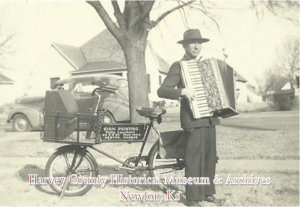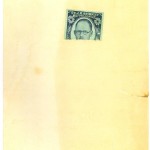by Kristine Schmucker, HCHM Curator
Tiny, dainty notes make this piece of music a visual work of art in addition to a sheet of music. HCHM Archives has two copies of a single sheet of music entitled, “Hail to our Newton.” There are only two clues to the history of this piece of paper.
At the bottom of the page:
“The notes and words are hand printed with a brush by Philip Launhart.”
and on the back – two halves of a campaign sticker from Dr. J.R. Brinkley for Kansas governor.
- Sheet music – Philip Launhart
Based on the stickers on the back, the sheet music could be dated to the mid-1930s. Dr. John R. Brinkley, also known as the goat gland doctor, ran unsuccessfully for Kansas governor in 1930, 1932 and 1934.
Update 2022
New info indicates the song was composed for the 1921 Newton Semi-Centennial Celebration. A volunteer played so we can hear how it sounded. Give it a listen.
Philip Haunhart, Jr
A search for information on the man who “hand painted” the music led to a story of the difficulties of pioneer life and starting over. According to his obituary, Philip J. Launhart was born in Poland on 19 February 1891 to Philip J. and Mary Hoffman Launhart. He had four older sisters; Katherine (1880), Mary (1884), Laura (1886), and Elizabeth (1888). The young family lived with Philip, Sr’s widowed mother in Poland/Prussia until she died. At that time, they decided to immigrate to the United States. Mary’s brother, Carl Hoffman, encouraged them to come to Kansas and settle in Hodgeman County, near him and his family.
“So different than . . . Germany”
The family immigrated and settled in Hodgeman County, Ks, in May 1893. Philip was 2. A second son, William, was born in Kansas. Mary later wrote about the first months on the Kansas prairie.
“Philip worked hard plowing and sewing the feed that spring, but due to the lack of rain, nothing grew. They hadn’t been in the country long enough to get firmly settled, so Philip hadn’t invested in cattle like most farmers in the area, so their livelihood was getting scarce. Philip and Mary had both begun to regret their move to America.”**
The family struggled through their first winter on the Kansas prairie. With the coming of spring and a new growing season, perhaps the elder Launhart’s felt a sense of optimism. However, one year after they arrived, tragedy struck the Launhart family. Mary later wrote;
“On May 9, 1894, in the afternoon, the two older children had gone to the neighbors to play, and about 4:00 in the afternoon a dark cloud was making its appearance from the Northwest. Philip was in the field when he saw the dark clouds coming so unusually fast, which was so different from the weather in Germany, he hurried home. “**
Once home, Philip gathered the family in the house. Three of the children were told to sit on the trunk in the bedroom, while Mary held baby William on her lap on the bed. Philip stood nearby. “All at once everything went black” and after a bit Mary realized something had happened. Her husband was laying on the floor, all of the windows were broken out, and the south wall of the bedroom was completely gone. She “couldn’t make out what had happened. She tried to revive Philip, but to no avail, he had died.”
Mary was left in a strange country with six small children and only 75 cents. She knew very few people since the focus of the family had been on establishing the farm. Even though he was not well known, Philip Launhart’s funeral was well attended. Mary described the funeral and her feelings.
“When the casket was in place to be lowered into the ground, the minister continued talking and later as it was being lowered, Mary seemed to be going down with it. She gave way and if it hadn’t been for a couple of neighbor men standing on each side of her, she would have fallen to the ground.”
Philip Launhart, Sr was buried in the Hanston Mennonite Cemetery, Hanston, Hodgeman County, Ks.
To support her family, Mary went to work as a housekeeper in the home of a widowed man by the name of Lewis Horn. Mary’s four older daughters went to work and board with other local families. Eventually, Mary married Horn. By the late 1890s, the blended family consisted of Horn’s son, William; Mary’s two sons; Philip and William; and Edward, their son together.
Lewis Horn was a man with a violent, unpredictable temper. In approximately 1900, his abuse of his eldest son William (13) became so violent that the young man ran away eventually coming to Halstead, Ks. Mary continued to live with Horn for approximately a year. Finally, in fear for her life, Mary left with her two sons, Philip and William, and moved to Newton, Ks. She later wrote of the abuse suffered at the hands of Lewis Horn and the threats made to her life.
Establishing a business in Newton, Kansas
After arriving in Newton, Philip, William, and their mother, Mary, lived at 226 SW 5th. As a teenager, Philip worked as a painter for the Santa Fe. Over the next several years, he was able to establish himself as a self employed sign painter.

Philip J. Launhart, Newton, Ks n.d.
Note advertisement on bicycle for sign painting business.
Photo courtesy Lynda Gregory Friesen.
William married Daisy Koppes and moved to a rural residence near Halstead. The couple raised four girls. Mary Hoffman Launhart died on 18 June 1943. Three years later Philip married Grace M. Brady. They continued living at the house at 226 SW 5th.
Philip died 5 February 1966 after a three week illness that required hospitalization at Bethel Deaconess Hospital, Newton. His wife, Grace, survived him. Other surviving family members included a brother, William of Newton, a sister, Mary Schmidt [Schmitt] of Hutchinson, and a half brother, Edward Horn of Hanston, Ks.
The initial question of the significance of the sheet music was not answered. However, the story of a pioneer mother’s courage and the resilience of her two sons was revealed.
Special thanks to Lynda Gregory Friesen for sharing the family history written by Mary Hoffman Launhart as well as the photo of Philip Launhart, Jr.
**Launhart, Mary Hoffman personal documents translated from German by Mary Launhart Schmitt edited by Lynda Gregory Friesen.
If you have information about the music, “Hail to our Newton,” please contact HCHM. An additional original copy of this music is located at the Mennonite Library and Archives, Bethel College, N. Newton, Ks.
Sources:
- Newton Kansan, 7 February 1966 obituary for Philip J. Launhart.
- Evening Kansan Republican, 18 June 1943, p. 4. Obituary for Mrs. Mary Launhart.
- Newton City Directories, 1905-1965.
- United States Census, 1900, 1930, 1940.
- United States World War I Draft Registration Cards, 1917-1918 Index.
- Find A Grave John Philip Launhart, Sr. (1854-1894)
- Launhart, Mary Hoffman personal documents translated by Mary Launhart Schmitt edited by Lynda Gregory Friesen on Find A Grave Memorial for Lewis C. Horn (1858-1941)
- Friesen, Lynda Gregory to Kristine Schmucker, e-mail correspondence dated April 11, April 12, April 14, April 15, 2014.



